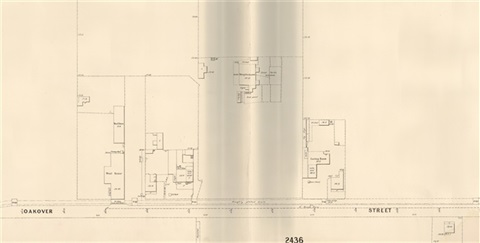Oakover Road from St. Georges Road to Gilbert Road

Oakover Road's origins stretch back to the early days of Preston's settlement, leading as it did to Oakover Hall, which dates from the 1850s. The road has a history which is in part industrial, agricultural and residential. This article will focus on the history of Oakover Road from St. George's Road through to Gilbert Road.
In 1856 the Shepherd family established Shepherd's Run on a block of land running from Bell Street up to Murray Road and from High Street to the Merri Creek. After the land was subdivided a number of tenant farms appeared. In the late 1180s this included Thomas Stripp, George Bryant, William Sutton and John Wilson. These farms seemed to concentrated largely on the southern side of Oakover Road.
The first industries appeared in 1892 with the appearance of a wool wash established by Caufield in what is now about 74 Oakover Road and a large brickworks on the south side of Oakover Road in what is now the Harry Swain Reserve. The main reason for the establishment of these industries appears to have been the development of a drain known as Bullen's drain which started as a natural watercourse and carried storm water to the Merri Creek. It originally flowed down Dundas Street but was extended north to Oakover road in 1889.
With the availability of a drain and water, industries began to appear on the north side of Oakover Road. Firstly J. Schofield took over the wool scourer business of Caulfield and then C. Devers and Co. established a bacon curing factory closer to St. Georges Road. In 1896 William Alexander established a slaughter yard next door to Dever's bacon factory. The following year George Alexander took over the slaughter yard and was to run it until the 1930s.
Meanwhile about the same time Walkerden's brickworks closed down. The 1896 Depression struck the construction industry hard and demand for bricks plummeted. On the south side the two dairy farmers still operating were Edward Hearn and David Bertram.
In 1904 Kelly and Ziebell opened a ham and bacon curers in the block of land between Schofield's wool scourers and Alexander's slaughter yard.
Six years later J. Schofield had passed his business onto T. Herley and Premier Oleo and Margarine factory had replaced Ziebell's ham and bacon curing factory.
Post World War One saw the growth of tanneries in the area. Dorrington & Railton established their tannery on the site of the wool scourers and J. Kupsch established the New Mark & Co. Tannery on the site of Devers bacon curers. On the south side of Oakover Road J. Hamilton, E. A. Sands and A. G. Sands still operated dairy farms but they were now joined by the Langford Tannery (between Burgess and Calbourne streets).
But the time of the small tanneries were short lived. By 1938 Dorrington & Railtons had become the Melbourne Bottle Company and the New Mark and Co. Tannery had become Premier Pottery. Premier Oleo and Manufacturing factory had become a flock manufacturer and meanwhile Alexander continued his slaughter yard uninterrupted, the only change being the swap from George Alexander to A. Alexander and Co.
The immediate post World War One period also saw the first land subdivisions for residential purposes appear and by the mid 1920s the first homes began to appear. At first the take up was slow but as the 20s moved into the 30s the pace began to pick up.
By the 1950s the area along Oakover Road was largely residential however this small string of industrial properties to the north continued to operate as small business as they do today.
Sands and McDougall’s Melbourne and Suburban Directory 1864- 1974. [Microfiche]. (1974). Melbourne, Australia: Sands & McDougall.